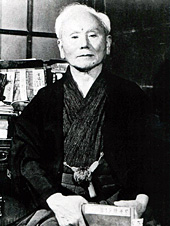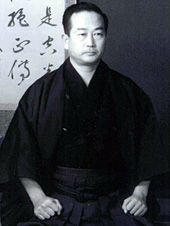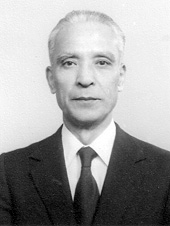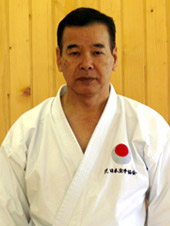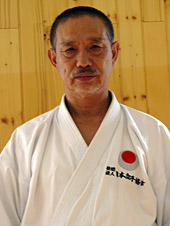Japan Karate Association
With a vast membership in over 100 countries, the Japan Karate Association is the world's largest and most prestigious karate organization. It is the only independent karate entity legally and officially recognized by the Japanese government as an association of members (Shadan Hojin) for the promotion of karate. There is only one other authorized entity which falls under the umbrella of the JKA: the JKA World Federation (JKA/WF). No other organization shares this status. Likewise, the JKA is not dependent upon or subordinate to any other group, organization or entity. However, there are instances in which the JKA cooperates of its own volition with other organizations in an equal stance.
the JKA is the preserver of the soul and spirit of the art of kokufu-bunka karate-do - karate based on the ancient Japanese tradition of bushido (the way of the samurai). Our mission is to promote this way of karate throughout the world, ensuring that it remains true to the philisophical precepts upon which it was founded.
For the most part, the JKA is centrally organized and coordinated through Tokyo JKA HQ, although there are both National and Regional headquarters in most areas around the world.
Supreme Master Funakoshi Gichin (1868 - 1957)
The Father of Modern Karate Funakoshi Gichin was born on Nov 10, 1868 in Yamakawa, Shuri, Okinawa Prefecture. He was of samurai lineage, from a family which in former times had been vassals of Ryukyu Dynasty nobles.
By age 11 he had already made a name for himself in Ryukyu-style martial arts. Beginning his training under Master Azato Anko, it wasn’t long before he equaled his master in ability, and shared with him the distinction of being the “most accomplished” martial artist in the field. He also learned karate-jutsu (written with characters that mean “Chinese-hand martial art”) from Master Itosu Anko. Both his teachers were impressed by his nobility of character.
As over the years he pursued his training and continuously developed his remarkable skills, Master Funakoshi became chairman of the Okinawa Martial Arts Society, as well as an instructor at the Okinawa Teacher’s School. Then in 1922, when he was 54 years old, he introduced Okinawan karate-jutsu at the first Ministry of Education (now Ministry of Education, Science, Sports, and Culture)-sponsored Physical Education Exhibition. This introduction, the first ever public display of karate-jutsu in Japan, was a stunning success. And the previously unknown martial artist Funakoshi Gichin rose to instant fame throughout the Japanese world of martial arts.
Immediately the founder of modern judo, Kano Jigoro, invited Master Funakoshi and his pupil Gima Shinkin to the Kodokan judo dojo to give a demonstration of kata. The highly-attended event filled the Kodokan dojo to capacity. It was so well-received that Master Funakoshi found himself pressed on all sides to stay in Tokyo.
Excited by the opportunity to further promote the martial art that he had done so much to introduce to Japan, Master Funakoshi subsequently began teaching it at Tokyo’s Meiseijuku, a dormitory for Okinawan students there. In 1922, he published a book entitled “Ryukyu Kempo Karate.” It was the first formal exposition in Japan on the art of karate-jutsu. Not only were its contents fresh and novel, it was also beautifully written, and immediately created an unprecedented karate boom.
As the popularity of karate-jutsu began to spread, Master Funakoshi produced the first ever “Dan Ranking Certification” in April, 1924.
Around the same time, with the encouragement of his teacher of Buddhism, Abbot Furukawa Gyodo of Enkakuji Temple in Kamakura, Master Funakoshi started practicing Zen. He contemplated the well-known Buddhist teaching that says “form is emptiness and emptiness is form.” He began to see the relevance of that teaching to his martial art, and ultimately changed the characters for karate from kara + te (“Chinese” + “hand”) to kara + te (“empty” + “hand”).
Then, in order to popularize the “local” Okinawan martial art in the rest of Japan, Master Funakoshi synthesized a complete system of techniques and theory, and changed the Chinese and Okinawan names of the kata into standard Japanese. In 1929, after much thought and reflection, he also changed the name of karate-jutsu (“Chinese-hand martial art”) to karate-do (“the way of karate,” or “the way of the empty hand”). He then defined the Twenty Precepts of Karate, and established a grand karate philosophy.
At last the way of karate had come into its own, and was gaining popularity all across Japan. The number of people wishing to begin training was growing daily—so much so that it became difficult to find a place for them to practice. So in 1939 Master Funakoshi established the “Shotokan” dojo, which he built at his own expense. (“Shoto” was the literary first name he used when doing calligraphy and writing poetry. “Shoto” means “Pine Waves,” and refers to the sound of wind blowing through the pines, which resembles the sound of ocean waves.)
By this time, Master Funakoshi had long been teaching karate to high-school and university students. As a result, karate clubs had sprung up at higher education institutions all over Japan—which is another reason why karate has become as respected as it is today.
In the air raids of World War II, the Shotokan dojo was destroyed, and the growth of karate came to a halt. But after the war, followers of Funakoshi’s way re-grouped, and in 1949 they formed the Japan Karate Association, with Funakoshi Gichin as Supreme Master.
On April 10, 1957, the Ministry of Education gave official recognition to the JKA, and it became a legal entity. A mere sixteen days later, at the age of 89, Master Funakoshi passed away. A large public memorial service was held at the Ryogoku Kokugikan (Ryogoku National Sumo Hall), attended by more than 20,000 people, including many famous names who came to pay their respects.
A memorial monument to Master Funakoshi was established at Enkakuji Temple in Kamakura. Members of the JKA pay an honorary visit on April 29th each year, the date of the Shoto Festival.
Master Nakayama Masatoshi (1913 - 1987)
Carrying On the Spirit and Tradition of Funakoshi Gichin's Work
Master Nakayama Masatoshi had martial arts in his blood. Born in April 1913 in Yamaguchi Prefecture, he was a descendant of the Sanada clan, in the Nagano region. His ancestors were highly-skilled instructors of kenjutsu (the art of swordsmanship).
Upon entering Takushoku University in 1932, Master Nakayama immediately joined the university’s karate club, studying under Master Funakoshi Gichin and one of the master’s sons, Funakoshi Yoshitaka. Deciding to devote his life to karate, he traveled to China after graduation for further study and training.
When he returned from China in May 1946, he got together with fellow Shotokan practitioners from his university days to revive the Shotokan karate tradition with Funakoshi Gichin as Supreme Master. Together in 1949, they established the Japan Karate Association. In 1955 a headquarters dojo was built at Yotsuya in Tokyo. It spurred the building of JKA branch dojo all across Japan.
The efforts of the Japan Karate Association to embody and promote the spirit of karate-do were highly regarded by the Ministry of Education (now Ministry of Education, Science, Sports, and Culture). In 1957, the Ministry granted the JKA exclusive legal recognition in Japan as an official association of members for the promotion of the way of karate.
During that time and over the next several years, Master Nakayama made immeasurable contributions to the art. He developed together with his fellow JKA instructors, a new, rational method of teaching that was tailored to the level and goals of each student: karate as a physical development tool, karate as a method of self-defense, karate for matches, etc. He also emphasized the necessity for each aspect of training to be physically and kinesthetically practical, and he scientifically analyzed how to make them so.
Moreover, to ensure that the true essence of karate-do was being passed on correctly, he and his disciples established a two-year specialist instructor training program, which is still the only specialist instruction system in the world of karate. And the training never ends; the JKA is, and always has been, the only karate organization whose full-time instructors continue to get together every day for joint practice. Through this program, JKA instructors constantly endeavor to refine and perfect their karate.
Master Nakayama also invented karate’s first match system: the first ever JKA All Japan Karate Championship was held at Tokyo Metropolitan Gymnasium in October, 1957—and was attended by so many participants and spectators that the venue was filled to capacity.
His adaptation of kata and kumite for the match system was a huge success; the 5th JKA All Japan Karate Championship in 1961 was even attended by His Majesty the Crown Prince of Japan (now His Majesty the Emperor of Japan). Karate was growing increasingly popular throughout the world.
Master Nakayama valued the spiritual aspects of karate that his teacher Funakoshi Gichin espoused—especially the virtue of modesty and the spirit of harmony. He never tired of teaching, by his example more than his words, that to demonstrate these qualities requires not only a deep sense of propriety, but also a constant remembrance that “there is no first attack in karate.”
In actual practice, Master Nakayama insisted that each technique should demonstrate one’s powerful and wholehearted personal best. He also emphasized that it is crucial to study the inseparable trinity of karate—kihon, kata, and kumite—as one. And he continually reminded everyone to keep in mind that “the way of karate we pursue is a bare-handed martial art which we practice with an unwavering heart in a state of emptiness; it is a way of developing the personality.”
In his later years, he summarized all his techniques and philosophy in the famous 11-volume series entitled “Best Karate.”
Master Nakayama passed away in 1987, at the age of 74.
Master Sugiura Motokuni
A Lifetime of Devotion to Karate
Master Sugiura Motokuni was born on Oct 4, 1924 in Aichi Prefecture. His karate career began in his youth, when he became a student of Shotokan karate. At university he studied under Supreme Master Funakoshi Gichin, and especially with Funakoshi’s second son Yoshitaka. He attained his 1st Dan at age 20.
After graduation in 1944, Master Sugiura spent a year in the Tsuchiura Navy Flying Corps, but he soon returned to the martial art he loved, resuming his karate training under Master Nakayama Masatoshi while holding a job at a junior college in Tokyo. During these years, he attained the rank of 3rd Dan.
In 1955, Master Sugiura gave up his job at the junior college and began working full-time in the JKA’s Guidance Division. He was also appointed director of the JKA, and assigned to managing the instructors at the headquarters dojo. It was the start of a lifetime of contribution to the art of karate. Not only did he teach at the JKA headquarters dojo, but he also helped establish the rules for tournaments, refereed at matches, and coached at as many as five universities around Tokyo.
In 1958, a year after the Japanese government granted the JKA official recognition, Master Sugiura received his university license as a Physical Education instructor. Over the next five years, he was a part-time Physical Education teacher and lecturer at Asia University, while also attaining his 6th Dan.
In the next decade he began producing materials to help promote the way of karate around the world. In 1961, he helped to edit the textbook “Basics of Karate-do,” which identified some common basic errors in karate techniques. In 1963, he created a six-volume, English-language 8mm film entitled “Karate Seminar.” In the summer of the same year, he resigned as Director of the JKA, and became a full-time Physical Education teacher.
Master Sugiura’s circle of activities kept on expanding. He served as president of the Koganei City Karatedo Federation and Physical Education Association. He joined the Japan Martial Arts Society. And he began creating, in partnership with Kodansha International Ltd., a five-volume video series in Japanese and English on the kata.
Soon Master Sugiura’s efforts were attracting attention outside Japan. He was invited to China and Taiwan for the Japan Friendship Karatedo Cup. Then, in August 1975, he went to Los Angeles and Hawaii to attend the International Amateur Karate Federation general meeting and see the JKA-sponsored 7th IAKF Championship. Shortly thereafter, “Monthly Karate-do” magazine began publishing his column.
1976 was another big year for international karate. In August 1976, Master Sugiura—now an 8th Dan, a Karate Technical Committee member, and a full-time professor at Asia University—accompanied the university Alumni Association on an historic visit to Indonesia. Then he was sent to the U.S. to observe how karate was being taught at several American universities.
The next year, Master Sugiura completed his thesis “A System of Karate-do,” which discussed the true essence of karate. He spent the next few years creating “Teaching Materials for Karate-do as Physical Education.” And in 1989, he drafted the supplementary karate guidelines for these materials.
In March 1990, Master Sugiura retired from his post at Asia University, and the next year was appointed as Chief Instructor of the JKA. In 1992, he received his 9th Dan.
One of Master Sugiura’s greatest gifts to the JKA has been his consistent focus on the basics: kihon, kumite and kata. As he emphasizes, kihon teaches us how to move, ensuring our technique is flawless; kumite teaches us how to concentrate, and how to best apply our technique for maximum power; kata teaches us both at once—and opens the way to the body-mind unity that is the soul of karate.
Master Ueki Masaaki
Chief Instructor of the Japan Karate Association.
Rank: 9th Dan Birthdate: Mar 24, 1939 Birthplace: Tokyo University: Asia University Started Karate: 3rd year of high school Motto: "Always remember the mind and body are one"
Major Tournament Wins· 18th JKA All Japan Karate Championship (1975)
1st Place Kata· 17th JKA All Japan Karate Championship (1974)
1st Place Kata· 14th JKA All Japan Karate Championship (1971)
Tournament Grand Champion; 1st Place Kata; 2nd Place Kumite· 11th JKA All Japan Karate Championship (1968)
Tournament Grand Champion; 1st Place Kumite; 1st Place Kata· 10th JKA All Japan Karate Championship (1967)
1st Place Kata· 9th JKA All Japan Karate Championship (1966)
2nd Place Kata· 8th JKA All Japan Karate Championship (1965)
Tournament Grand Champion; 1st Place Kata; 2nd Place Kumite
Master Tanaka Masahiko
Vice Chief Instructor of the Japan Karate Association
Rank: 8th Dan Birthdate: Feb 24, 1941 Birthplace: Tokyo University: Japan University Started Karate: 2nd year of university Motto: "Great-heartedness in the face of all"
Major Tournament Wins· 3rd IAKF World Karate Championship (Bremen, 1980)
1st Place Group Kumite· 2nd IAKF World Karate Championship (Tokyo, 1977)
1st Place Kumite· 1st IAKF World Karate Championship (Los Angeles, 1975)
1st Place Kumite· 18th JKA All Japan Karate Championship (1975)
1st Place Kumite· 17th JKA All Japan Karate Championship (1974)
1st Place Kumite· 16th JKA All Japan Karate Championship (1973)
3rd Place Kumite


